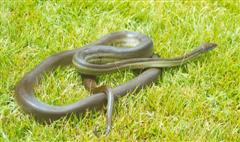Python - Olive
Olive Python Scientific Name: Liasis o. olivaceus
Sun, 13th July, 2025 - 7:11 am GMT
Sponsor Ads:

Alternative Name
Olive Python Scientific Name: Liasis o. olivaceusBasic Info
The Olive Python usually grows to between 8 and 12 feet (two and a half to four meters) long, and its head is well defined. The skin is fairly loose with a uniform green to brown coloration. Shades range from olive green to chocolate brown, and the underside of Olive Pythons is usually creamy in color. The lips are also creamy white, and often have brown or light gray freckles. The scales of Olive Pythons are usually very fine or small, and although most captive bred snakes achieve a thick girth, many wild caught specimens are rather lean.
Health
Because of their large size, Olive Pythons will usually require a great deal of space. Although these pythons appear to be mostly nocturnal in the wild, they are often active during the day in captivity. Their enclosures should reflect their preference for an arid habitat in a monsoonal area. It has been reported that these snakes have done well under conditions similar to those commonly used for captive Water Pythons, but they should be kept at lower humidity levels. Breeding In the wild, Olive Pythons usually lay eggs in the late spring, when 12 to 40 eggs are deposited. The hatchlings are about 35 centimeters long, and will emerge after about 50 days of incubation. Little is known about breeding Olive Pythons in captivity, and it has not been achieved often on a well-documented basis. However, a 100% hatch rate has been reported for eggs incubated between 25.5 and 30 degrees Celsius in average to high humidity levels.Habitat
Usually these snakes are found in arid rocky areas west of the Great Divide.Behavior
The large, though normally docile, Olive Python is a truly impressive snake. The rather plain coloration of these snakes may not be as elaborate as that of some intensely patterned pythons, but the simple beauty of the Olive Python is considered by many to rival that of multi-colored snakes. Often active at night in the wild, Olive Pythons hunt small mammals, and have been known to take animals as large as wallabies. Reptiles, particularly monitors, are often taken. When they are not moving about, Olive Pythons hide in rock crevices, termite mounds, or hollow logs. In association with humans, Olive Pythons usually will only bite as a last resort, if they are being harassed or disturbed. In captivity, Olive Pythons are known as "gentle giants" because of their relatively non-aggressive temperaments. This is not to say that these snakes will not bite; often they become very aggressive during feeding and may mistakenly injure a handler. Olive Pythons often have voracious appetites, and unlike many snakes that can be picky eaters, most Olive Pythons usually do not have feeding problems.Origin
AustraliaHistory
One of the largest pythons found in northern Australia, the Olive Python has a monsoonal western range. They are well known in Western Australia, where they range down the coast. Some aboriginal peoples believe the Olive Python to be an incarnation of the rain serpent, the mythological creator of earthly material things. They are not often kept in captivity.Common Foods
N/ASponsor Ads:
There's no limit to what a man can achieve, if he doesn't care who gets the credit. --Laing Burns, Jr.
Python - Olive
Coded by: BGID® | ALL RIGHTS RESERVED Copyright © 2000-2025
Disclaimer | Privacy | Report Errors / Contact | Credits










